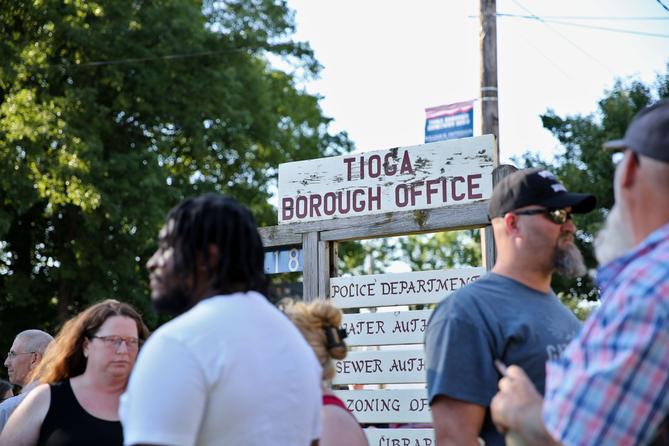This story was produced by the State College regional bureau of Spotlight PA, an independent, nonpartisan newsroom dedicated to investigative and public-service journalism for Pennsylvania. Sign up for our regional newsletter, Talk of the Town.
A December Spotlight PA investigation detailed how the government of Tioga, a small borough in northern Pennsylvania, nearly collapsed after a controversial police hire unearthed disorganization, personal vendettas among elected officials, and a lack of critical oversight.
The investigation raised questions about transparency and accountability in local governments, including whether taxpayers are best served by Pennsylvania’s fragmented system of more than 2,500 cities, townships, and boroughs.
Spotlight PA hosted a panel Jan. 26 to discuss those challenges. Min Xian, the newsroom’s local accountability reporter, joined Matthew Creme Jr., a municipal lawyer; Melissa Melewsky, media law counsel of the Pennsylvania NewsMedia Association; and David Rusk, a senior fellow at the D.C. Policy Center.
Here are five takeaways from the panel discussion, which can be viewed in full here.
Pennsylvania has what are called “little boxes” governments
In a 2003 study titled “‘Little Boxes’ — Limited Horizons,” Rusk detailed how local governments in Pennsylvania exist within fixed boundaries among cities, boroughs, and townships.
Pennsylvania has no unincorporated land, in contrast to “big box” states where county governments usually are only in more densely developed areas, allowing for land annexation that can follow regional development.
Rusk wrote in his study that the “little boxes” structure makes municipalities highly reliant on local property taxes, which tend to come from more homogeneous tax bases. This links to a higher degree of racial and economic segregation. Coupled with competition for limited resources — like federal and state funding — “little boxes” slow economic growth in many parts of Pennsylvania.
Fragmentation of local government burdens smaller municipalities
Pennsylvania municipalities vary widely in size, but the same sets of rules determine their organization and responsibilities. Regardless of their capabilities, each local government must provide the same level of basic services to taxpayers. This uniform standard imposes disproportionate costs of operation, especially on smaller municipalities.
“A municipality with 300 households has to enforce the same stormwater management regulations as a municipality with 2,500 households,” Creme said during the panel discussion.
Rusk added that the resource disparity might have contributed to a less cooperative mindset among elected officials.
“The almost unspoken mission of every little box government and every little box school district is to keep our town or keep our schools just the way they are, for people just like us, whoever ‘us’ happens to be,” he said.
More governments require more oversight
The many layers of local government can make public oversight of their workings more cumbersome. Pennsylvanians may find themselves having to keep track of the actions of multiple decision-making bodies because of it.
Newsrooms and advocacy groups can serve as watchdogs, but they face some of the same obstacles to information as residents. Melewsky advised that the best places for residents to start looking into local affairs are the websites of local governments (if available). She acknowledged that “many, many local governments are just too small or not tech savvy enough to have one” — another consequence of the “little boxes” design.
Citizens are empowered to attend public meetings and seek public records, through Pennsylvania’s Sunshine Act and the Right-to-Know Law, Melewsky said.
Some audience members shared barriers they’ve faced when they interact with local governments, including unfamiliarity with the laws and their rights, as well as threats from officials when they pointed out rule violations.
Melewsky suggested asking for information directly from agencies, when possible, as an approach to bypass the potentially time-consuming open records process. She also encouraged residents to inform lawmakers when their local government is not forthcoming or accessible, which could lead to policy changes.
Panelists offered different potential fixes for local government issues
The panel’s recommendations for opening up the many “little boxes” and improving government services went in several directions.
The state legislature could consider setting standards so that fiscally disadvantaged cities, townships, and boroughs would be forced to disincorporate and be absorbed by other municipalities, Creme said.
Local governments can work together and take advantage of regional planning or combining some services like firefighting and water management, he added.
Large-scale change would likely have to come from the legislature, Rusk said, as lawmakers have the constitutional authority to transfer the responsibility of municipal services to county governments.
But Rusk said he doubts there is enough political will for such major changes.
“Those are possibilities, but they require your government and your legislature to recognize that the very structure of little box governments in Pennsylvania is a significant problem,” Rusk said. “And most of them do not.”
Fewer governments could also mean fewer local identities
Many audience members asked how regionalization — functional cooperation among multiple local governments — and mergers and consolidations of municipalities could improve the current system.
Mergers and consolidations are one option, but they require approval from voters in all affected municipalities.
In 2021, residents from DuBois and nearby Sandy Township in Clearfield County voted to consolidate the two municipalities — their fourth attempt. The effort was approved three times by city residents and rejected three times by township voters in 1989, 1995, and 2002. The consolidation now underway might take years to complete.
Onerous procedure aside, the potential loss of local identity often dissuades residents from backing these measures.
“Local government, constitutionally, is the creature of state government. But emotionally, local government is the creature of the citizens,” Rusk said.
SUPPORT THIS JOURNALISM and help us reinvigorate local news in north-central Pennsylvania at spotlightpa.org/statecollege. Spotlight PA is funded by foundations and readers like you who are committed to accountability and public-service journalism that gets results.

